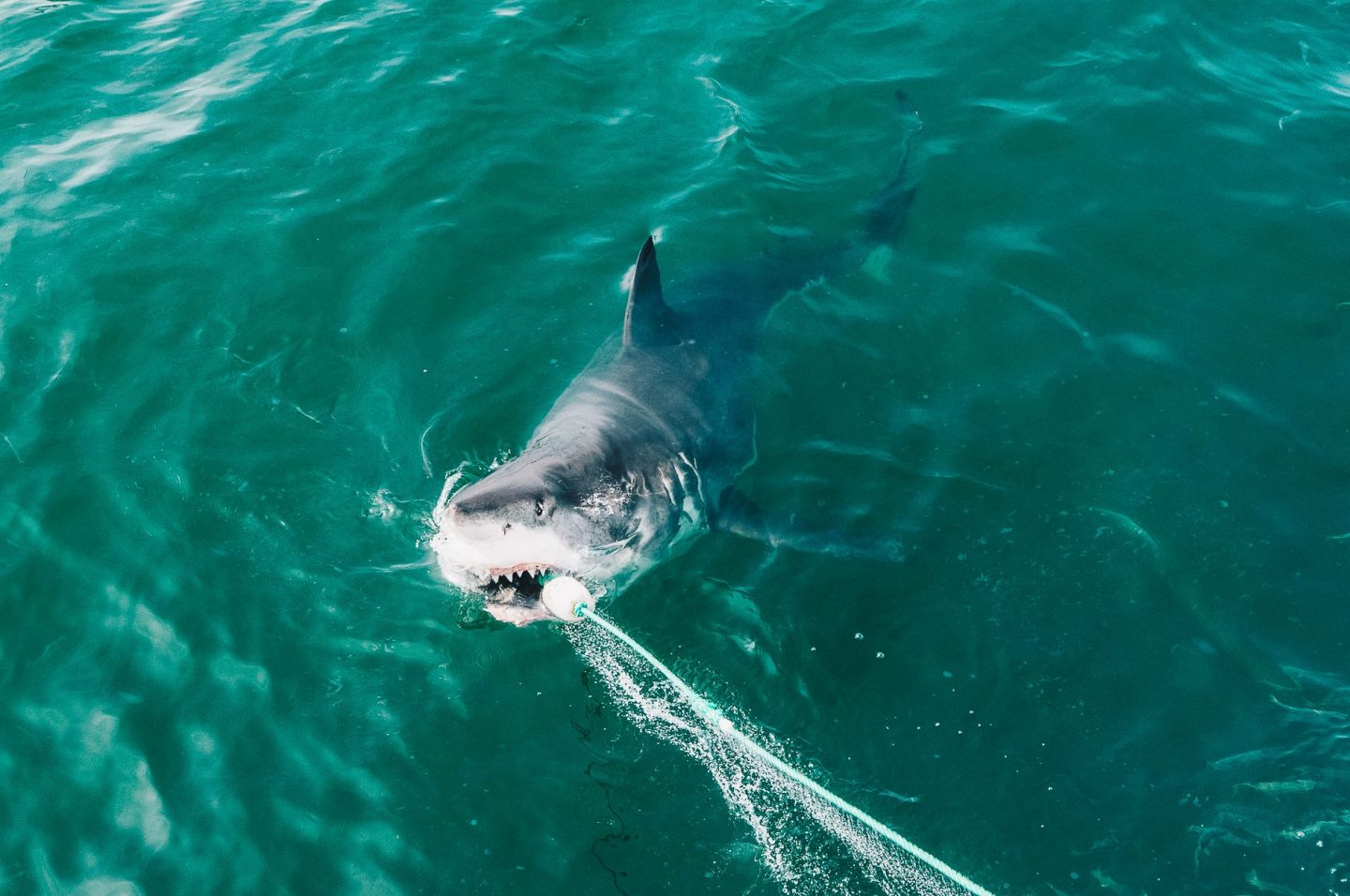
Welcome to Gansbaai, an American-style fishing village with grid streets in the southern part of the Western Cape province. Seemingly very quiet, Gansbaai attracts thousands of visitors each year for the whale watching, but especially for the star attraction, diving in the cage with the great white shark!
Sharks have always fascinated and frightened us. Today, however, this animal is hunted all over the world for its fins, reputed to be an aphrodisiac. There are 440 known species of shark in the world, and some species such as hammerheads are now endangered. The shark is an important animal in the food chain, and we need to change our prejudices about this not-so-ferocious animal!
There are many shark-watching areas around the world, but the great white shark is the king of all sharks and one of the oceans’ greatest predatory fish! It is mainly found in coastal areas of temperate seas, and occasionally in tropical seas. It can be found in South Africa, Australia, New Zealand, New Caledonia, the Pacific coast of the United States and Mexico (Guadalupe Island), and occasionally in the Caribbean.
Take a look at our other articles on South Africa to help you prepare for your trip:
- What to visit in Cape Town
- What to see in Knysna
- Cooking classes and recipes at Bo Kaap
- The wine route from Franschhoek to stellenbosh
- What to do in Oudtshoorn
- Cape Peninsula must-sees
- A practical guide to planning your tripWhat to do in Oudtshoorn
TABLE OF CONTENTS :
| WHERE TO SWIM WITH THE WHITE SHARK
The best-known places to truly observe it underwater in a steel cage are Port Lincoln not far from Adelaide in Australia. You dive into the cage with oxygen cylinders, but also Gansbaai in South Africa but you’re only with the mask and have to take a breath every time, and finally Guadalupe Island in Baja California with its warm, clear waters. (July to November)
| CAGE DIVING, FOR OR AGAINST?
For your information, “cage diving” as it’s known, involves swimming in a square steel cage underwater, to observe the sharks that are often lured with a liquid mixture of oil, fish and blood. Diving is done without a tank, so everyone can take part, but there’s a height requirement to hold on tight to the bars and put your feet inside the cage. Numerous agencies in Gansbaai and Kleinbai (boat departure points) offer these excursions, but we have chosen this tour provider for its eco-responsible policy. Indeed, it does not practice “Feeding”, i.e. feeding sharks to bait them!
➡️ Check the availability of the provider and book the excursion
There are many opinions on this activity. Indeed, some say it can distort the behavior of sharks, which are shy and fearful animals that don’t approach humans. Baiting them with blood excites them and makes them aggressive. Sharks are no longer as fearful and can associate humans with food, which becomes dangerous for divers. In some videos on Youtube, sharks injure themselves inside the cages, getting their heads stuck between the bars or sometimes jumping into the cage.
It seems that in Australia, the phenomenon is a little different because the cage is not on the surface of the water but 30 meters below. Sharks are therefore much more zen and therefore more natural.
Now, let’s not see the negative everywhere, and I’m the first to ask about this kind of practice, as I still aspire to observe animals in their environment and without it being harmful to them. South African biologists have nevertheless defended the practice, pointing out that the white shark cage doesn’t distort the behavior of these animals, and also demystifies the myth of the “man-eating” shark while providing another approach to the shark. C is also an important economic issue for the country but who allows the preservation of the species and especially the maintenance of the prohibition of fishing sharks. And for the first time, the roles are reversed: it’s the man who’s locked in a cage, not the other way round!
Finally, I read that a charter and a best practice guide have just been published to provide an ethical framework for shark watching. New standards have also been imposed for all providers selling this type of exit. Indeed, it is now mandatory to have the latest steel cages with a bar width that no longer allows sharks to injure themselves.
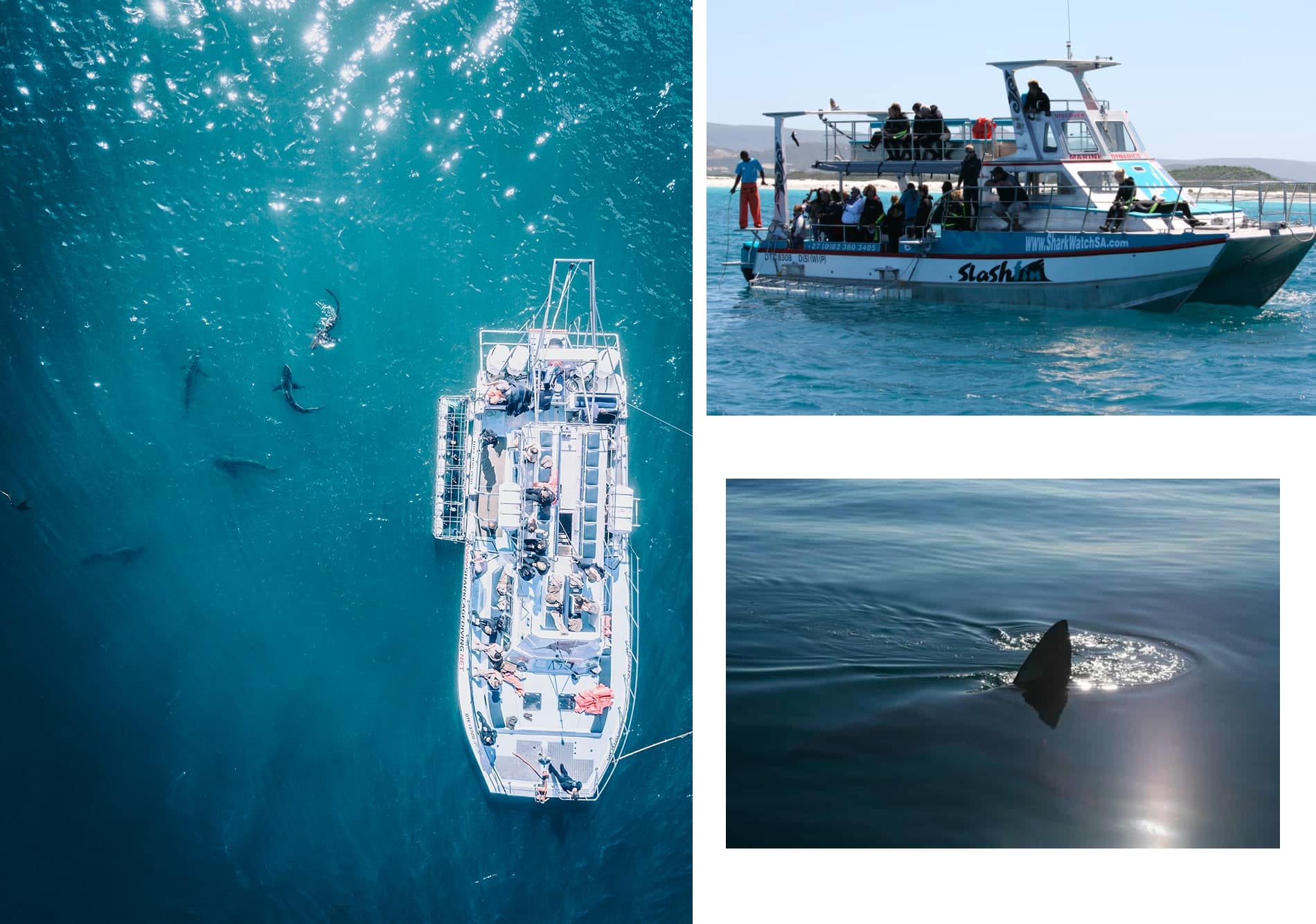
| BREAKDOWN OF THE DAY
As our excursion was scheduled for 1pm, our day began with an included lunch around the activity presentation brief. We then joined the boat in the harbor and headed out to sea. The crossing didn’t take long: 15 minutes later we were on the spot. No sooner had the boat stopped than the first fin appeared on the surface. (I want to be clear that our boat dumped into the water what they call “chum”, a liquid made from fish and tuna oil before diving the cage into the water. Some boats throw real pieces of fish)
While the crew lowered the large cage and launched the plastic turtle bait, we listened to the safety instructions as we donned our full neoprene wetsuits, trying not to fall off of course, as the swell rocked us from side to side! The excitement was building, our hearts were racing and the water temperature was around 12 degrees, so we weren’t being too proud!
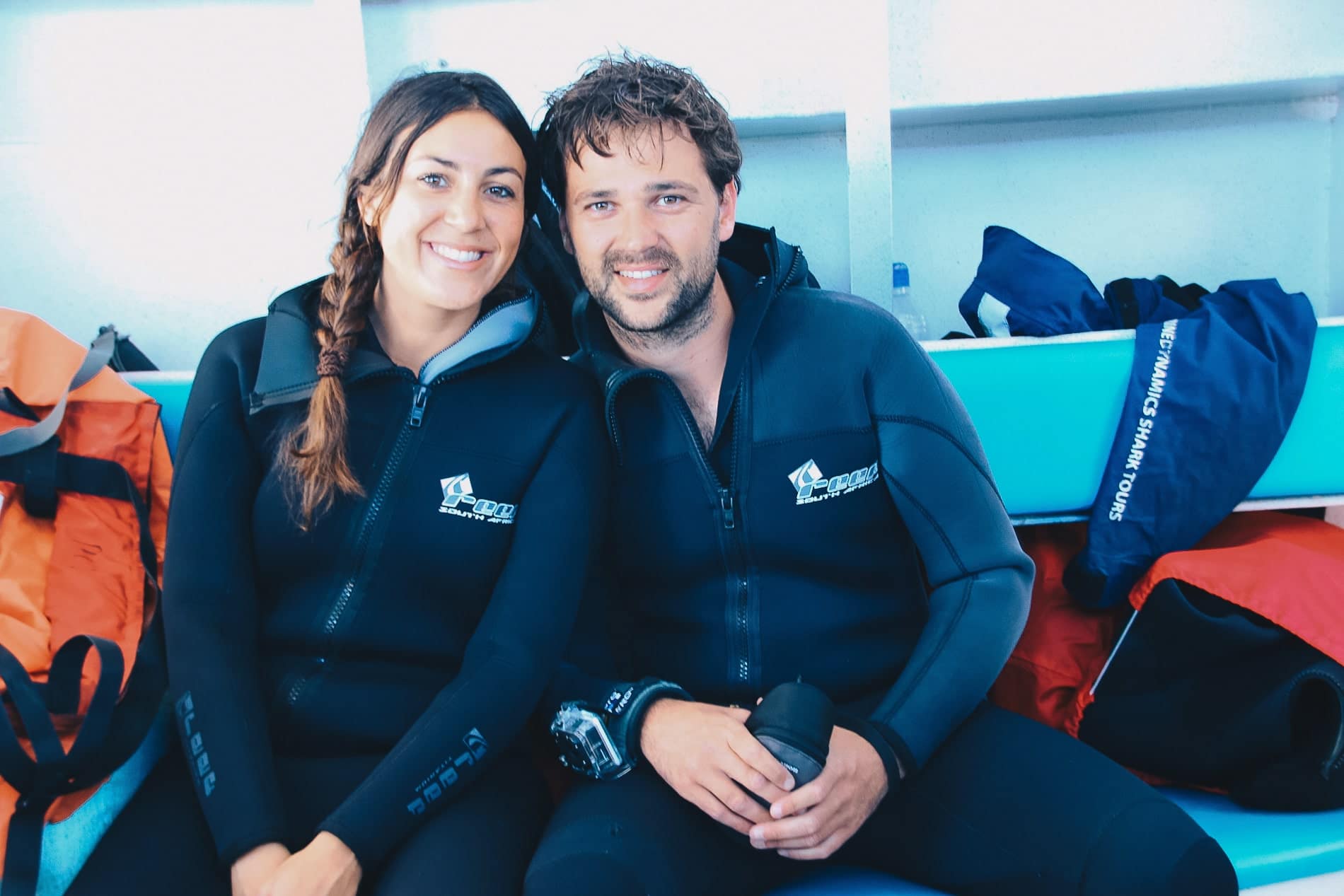
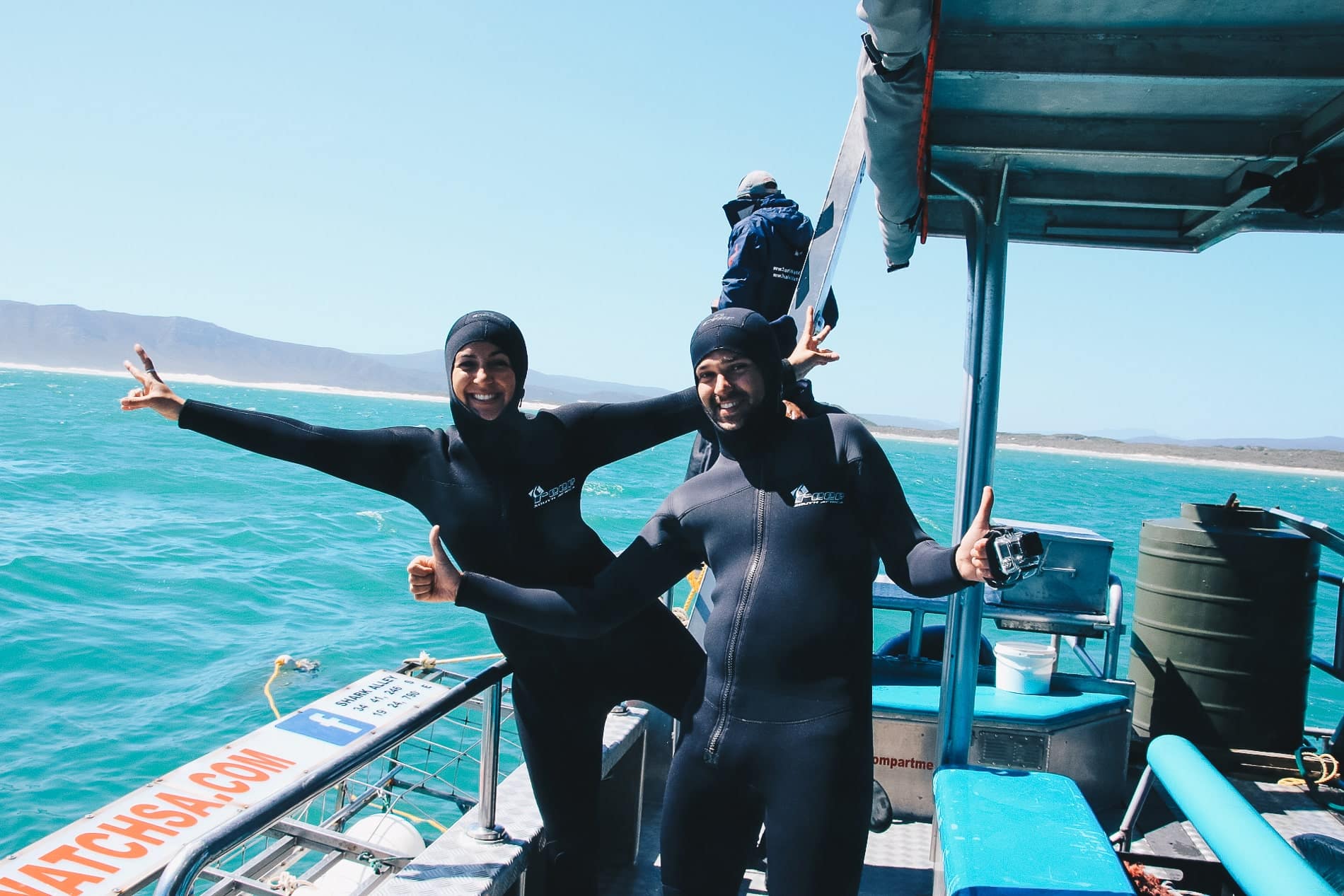
| OUR EXPERIENCE IN THE CAGE
Once you’re ready, you can take turns immersing yourself in the cage to come face to face with this incredible animal with razor-sharp teeth. But who said that sharks like warm water? South Africa’s waters are frozen! (20 minutes in the cage at this temperature is not easy for a southerner like me).
No sooner had we settled into the cage than the great white shark was approaching! The crew shouted : DOWN !!!! (which meant down below, head under water). We are executed but visibility under water was not very good. We could see the animal better from the surface of the water.
He approached again, this time very closely, and slapped the cage with his tail. The action happened very quickly, but he leapt out of the water before our very eyes to grab the plastic decoys the crew had handed him. The shark was 3 meters long, but we have to admit that from the cage we didn’t realize it! Our memory of it is rather of a large black mass passing in front of us, violently shaking the cage, jostling us and causing us to sink underwater! Sensations guaranteed!
After 20 minutes in the water, it’s time for other people to join in! On board, the crew is very attentive and has brought us hot chocolate and snacks as we leave the water. The view from the bridge is just as good, if not better! We could see these majestic creatures roaming around or jumping around the cage. The chills are guaranteed when we see them emerge from the water with their iconic mouths! Once back in port, after spending 4 to 5 hours on the boat, you’ll enjoy the hot soup served in the restaurant, while contemplating the souvenir video you can buy at the end!
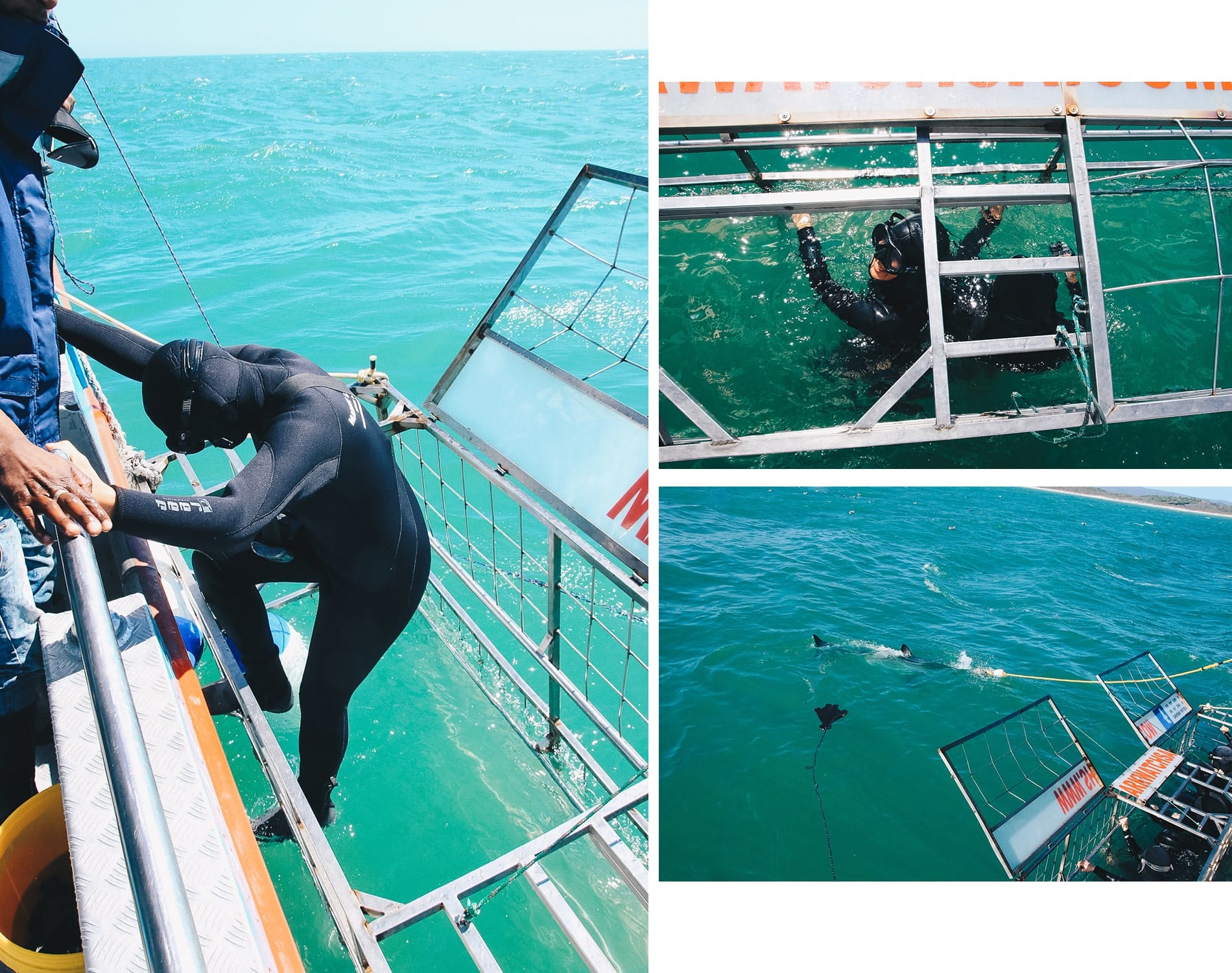
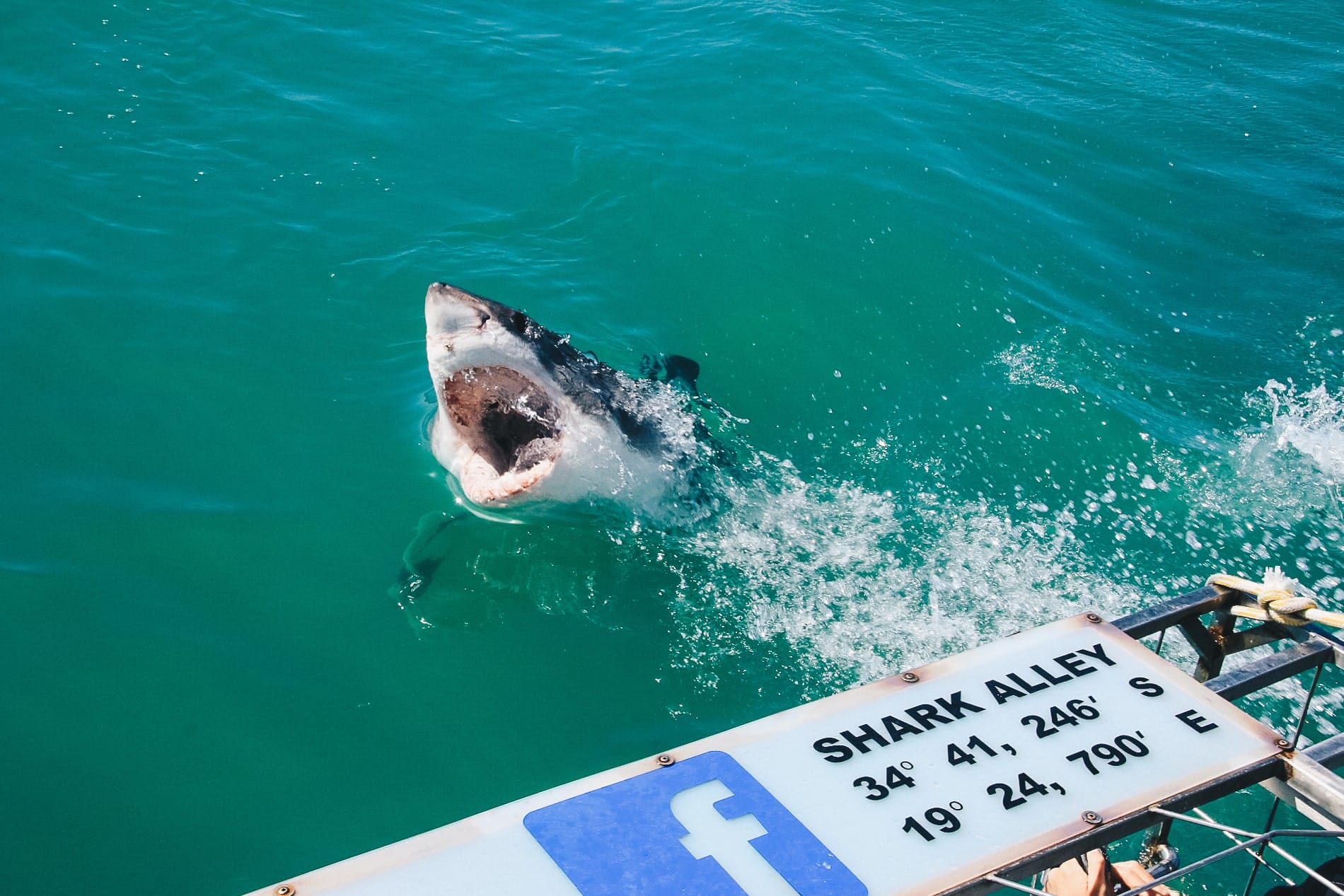
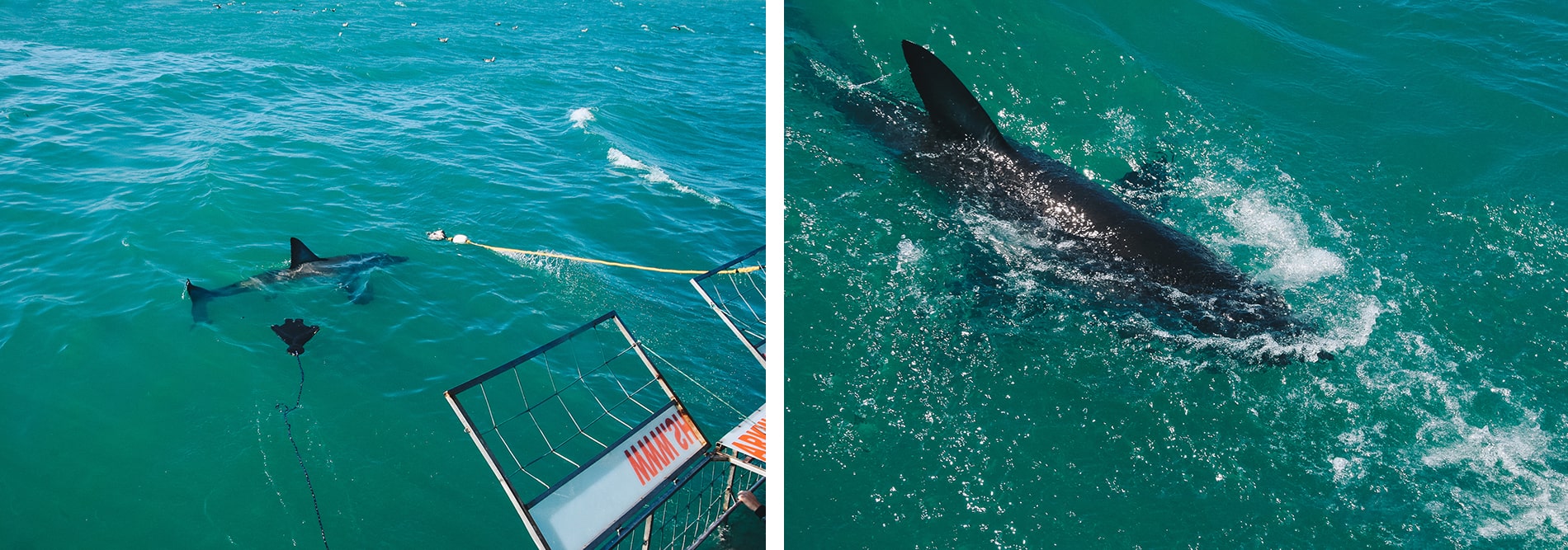
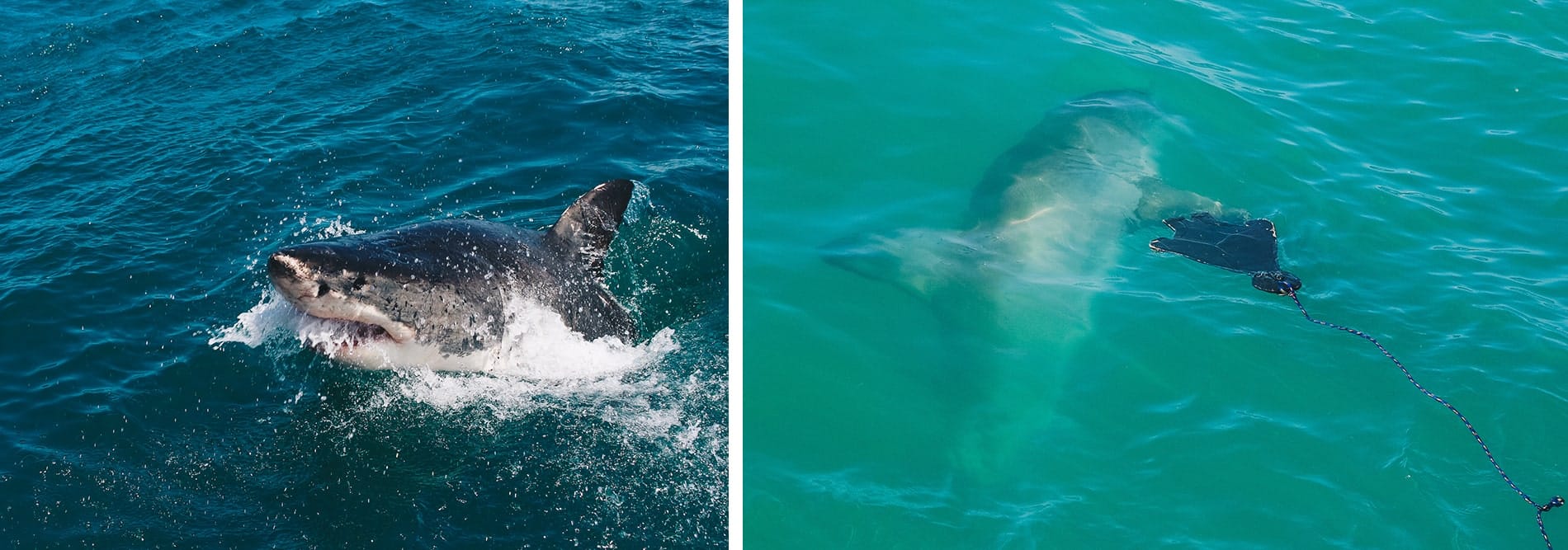
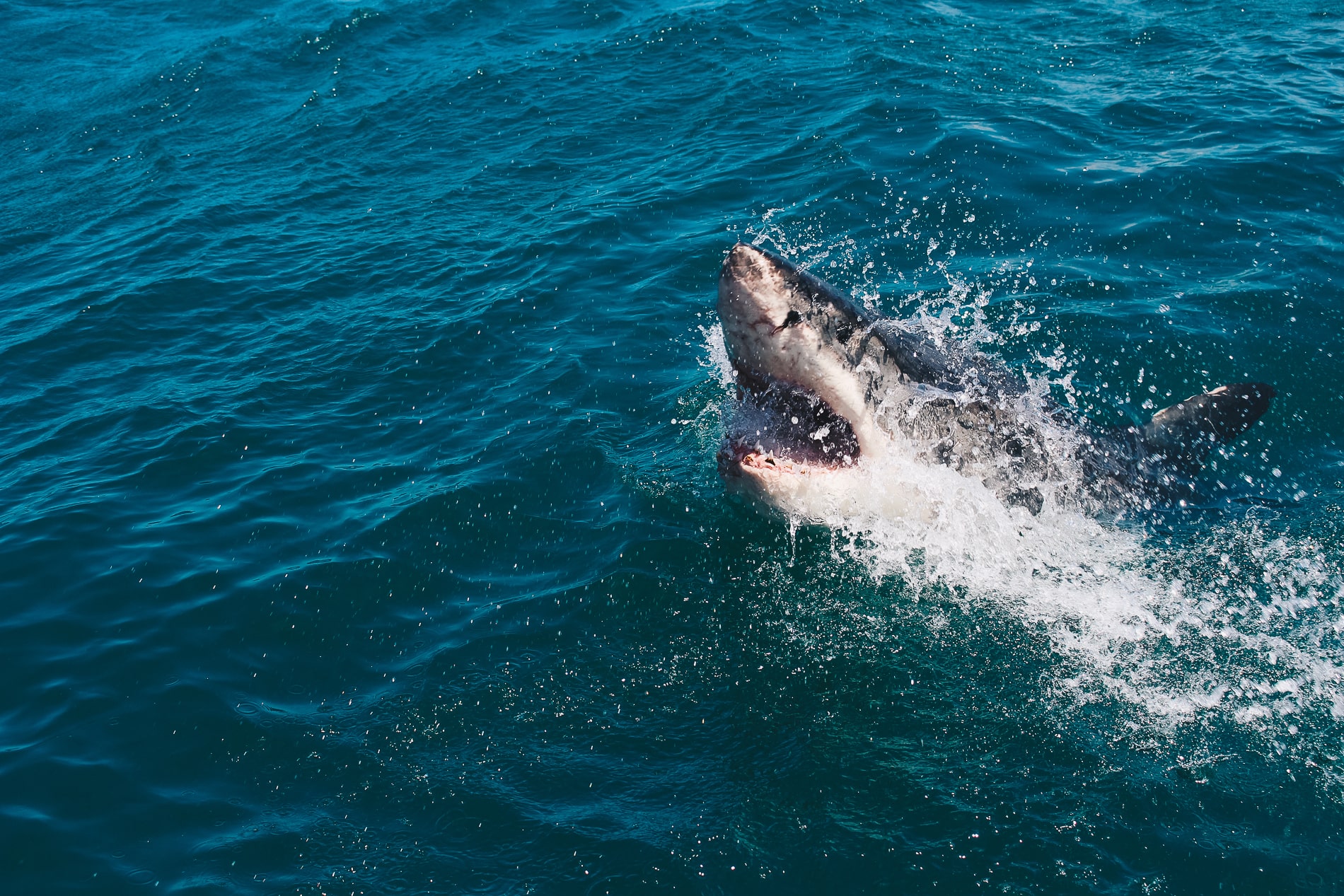
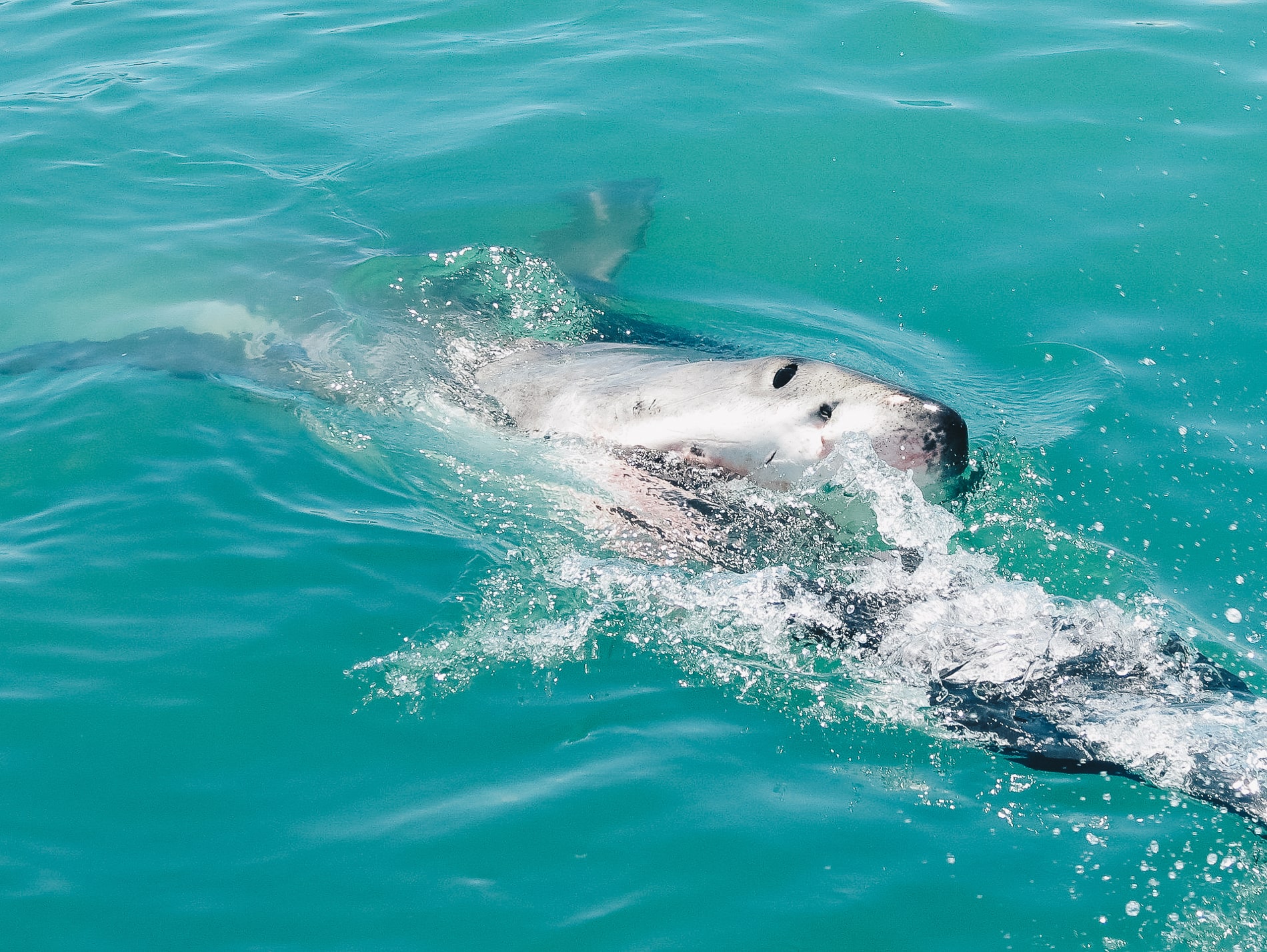
| BEST TIME TO SEE WHITE SHARKS
In terms of visibility, the best time to observe the white shark is in winter, in June, July and August. The water is clearer, sea lions colonize the coasts more, which favors hunting and therefore the presence of sharks. We tested the activity in February 2015. Conditions were not the best: strong winds, rougher seas and reduced visibility. At this time of year, it’s harder for boats to get out to sea because of the swell! The day before our arrival, the outing had been cancelled.
| WHERE TO SLEEP IN GANSBAAI
If you’ve come to Gansbaai, you’re probably planning to meet the white shark. Situated just a 2-hour drive from Cape Town, this is a good place to get a good night’s sleep before heading out to catch some early morning shivers! We present the hotel Gansbaai Lodge Backpackers.
Located in the center of the village, you can choose between a double room, a family room with a double bed and 2 bunk beds, 2 dormitories for 4 people or a 2-bedroom apartment on the first floor.
Warm ambience in this very wooded backpackers opening onto a terrace overlooking the small port of Gansbaai. It’s easy to imagine the sharks out there as the sun sets!
Attention, remember to book in high season because accommodation in the city is scarce! To get to the port, where the boat leaves for the activity, you’ll need a car, as we didn’t see any local transport! Maybe there are, but on that day they weren’t working.
To find your accommodation in Gansbaai, please check availability:
| FARES AND DIRECTIONS TO GANSBAAI
- If you choose our provider, count from 139€/p the exit from Gansbaai. If the weather is good and you are lucky to see white sharks, the activity can last from 2 to 3 hours. If the sharks take a long time to come, the crew will stay 1 to 2 hours longer to give you the thrills you’re waiting for. They really do their best, but only nature decides! Depending on the season, you may also encounter dolphins, sea lions, cormorants and other species roaming around the white shark.
- Gansbaai is a 2-hour drive from Cape Town. Find here your cheapest car rental
- Whale watching: June to November
Below you’ll find a selection of excursions offering this unique experience with sharks and other marine mammals.
➡️ Check availability in Gansbaai and book
At Gansbaai, it’s also possible to take a boat trip to watch the famous Big 5 sailors in the same day: whales, seals, sharks, dolphins and penguins. We wanted to book it, but due to bad weather, the excursion was cancelled.
➡️ Check availability for Big 5 Sailors and make a reservation

Diving into the water to come face-to-face with a great white shark was one of the coolest experiences we had on our round-the-world trip. Will you be tempted by the experience? Do you dare to enter the great white shark’s cage? Please note that as an accredited bespoke tour creator, I offer to accompany you in the creation of your tailor-made stay in South Africa and create a personalized itinerary tailored to your needs. Please send me an email at : contact@mademoiselle-voyage.fr
Before you leave, I also invite you to read our various articles to prepare your trip to South Africa:
- What to visit in Cape Town
- What to see in Knysna
- Cooking classes and recipes at Bo Kaap
- The wine route from Franschhoek to stellenbosh
- What to do in Oudtshoorn
- Cape Peninsula must-sees
- A practical guide to planning your tripWhat to do in Oudtshoorn

